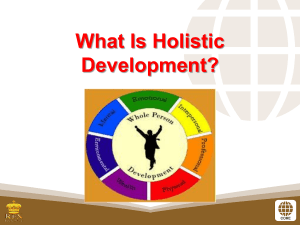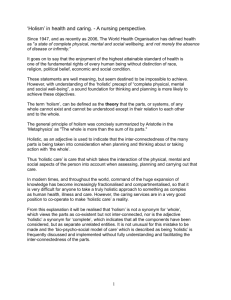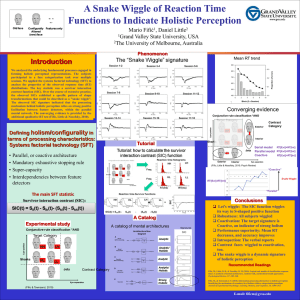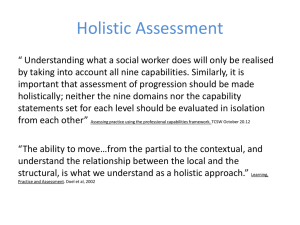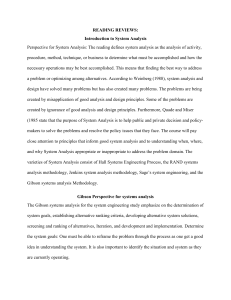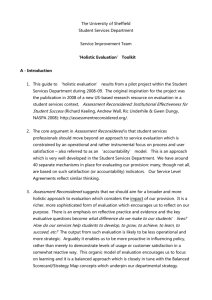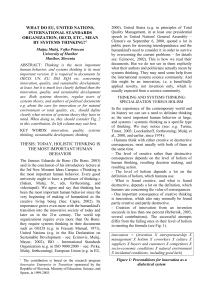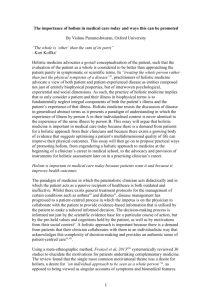Holistic approach and regional dimensions of environmental issues
advertisement
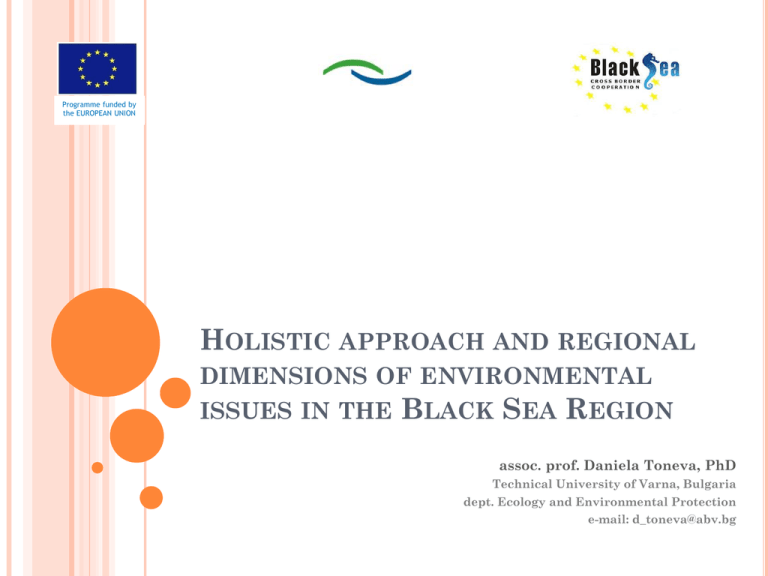
Programme funded by the EUROPEAN UNION HOLISTIC APPROACH AND REGIONAL DIMENSIONS OF ENVIRONMENTAL ISSUES IN THE BLACK SEA REGION assoc. prof. Daniela Toneva, PhD Technical University of Varna, Bulgaria dept. Ecology and Environmental Protection e-mail: d_toneva@abv.bg WHAT IS HOLISM? WHAT DOES THE HOLISTIC APPROACH MEANS? The term holism was coined in 1926 by Jan Smuts in his book, Holism and Evolution. Smuts defined holism as "The tendency in nature to form wholes that are greater than the sum of the parts through creative evolution”. Holism may be is sometimes seen as the opposite of Reductionism. Reductionism in science says that a complex system can be explained by reduction to its fundamental parts. (For example, the processes of biology are reducible to chemistry and the laws of chemistry are explained by physics). WHAT IS HOLISM? WHAT DOES THE HOLISTIC APPROACH MEANS? Holism, in the contrary claims that: The functionality of the systems is different from functionality of its main subsystems; Even the full scale subsystem’s efficiency doesn’t necessarily means efficiency of the System The complex systems, such as ecosystems and sociosystems evolving through meta-system transitions, when a new level(s) of complicity and hierarchy appears. META- SYSTEM TRANSITION HOLISTIC APPROACH + ENVIRONMENTAL ISSUES = ? The holistic approach considers the complex systems as a subsystems, a part of a higher range system For example, each ecosystem is a part of the a higher range system - biosphere. All land and marine ecosystems are connected to each other and forms the biosphere. Something more, they are interconnected and interdependent. In order to fully understand and predict the ecosystem’s behavior the holistic approach put focus on the hierarchical connections and the whole. IMPLEMENTATION OF HOLISTIC APPROACH WHEN? Strong hierarchical structures Complexity Variety of elements Social issues Economical issues Environmental issues Common challenges HOLISTIC APPROACH IN PROBLEM SOLVING. THE IMPLEMENTATION STEP BY STEP HOLISTIC APPROACH IN PROBLEM SOLVING. HOW TO IMPLEMENT IT EASIER? We define the issues as local, national, regional, global…, but our definition of the environmental issues depends of our capacity, knowledge, experience and perspective! To achieve better results and to benefit more from holistic approach implementation: Mapping: not only the local and national dimensions of the issue, but also the regional dimensions Follow the aim – ensure the regional impact of your action Networking – cooperate and provide mutual learning process Coordination – work together as a higher range System NATIONAL AND REGIONAL DIMENSIONS OF ENVIRONMENTAL ISSUES IN THE BLACK SEA REGION I Offer You a Challenge: 1. Write down at least 3 dimensions of environmental issues (for your country or costal area) 2. Write down at least 3 regional dimensions of environmental issues in the Black Sea Region 3. Now Compeer WATER Programme funded by the EUROPEAN UNION MANAGEMENT FISHERY AND AQUACULTURE Programme funded by the EUROPEAN UNION COSTAL MANAGEMENT Programme funded by the EUROPEAN UNION DEFORESTATION Programme funded by the EUROPEAN UNION NATURE Programme funded by the EUROPEAN UNION ENERGY AND ENERGY SOURCES Programme funded by the EUROPEAN UNION POLLUTION AND LOSS OF BIODIVERSITY Programme funded by the EUROPEAN UNION WAIST TREATMENT Programme funded by the EUROPEAN UNION PUBLIC AWARENESS AND EDUCATION Programme funded by the EUROPEAN UNION PRESERVATION AND PROTECTED AREAS ADDRESSING COMMON CHALLENGES Feedback from the documents: Agenda 21 Black Sea Biodiversity and Landscape Conservation (2002) The Convention on the Protection of the Black Sea Against Pollution (Bucharest) NATURA 2000 Black Sea Basin JOP Programme funded by the EUROPEAN UNION Stop looking at the tree! SEE THE FOREST! THANK YOU FOR YOUR ATTENTION!
